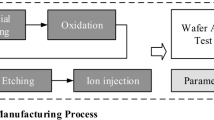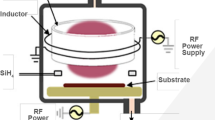Abstract
From raw silicon to a finished integrated circuit (IC), a typical semiconductor manufacturing process involves wafer fabrication, wafer probe, assembly, and final test. Before an IC is delivered to customers, it undergoes final test where its overall functionality is verified. This stage is where low yield issue is often encountered and with yield having a direct impact on a company’s revenue, it is considered a critical key process indicator. To the best of the author’s research, this is the first study to use both continuous and categorical front-end (excluding WAT parameters) and back-end variables to predict final test yield through regression analysis. A three-year amount of real production data was used to train, validate, and evaluate 11 different regressors. A genetic algorithm is also implemented for feature reduction. Results show that the optimized Bagging Regression model has a R2 score of 0.6813 with an average mean absolute error of 0.3902%.
Access this chapter
Tax calculation will be finalised at checkout
Purchases are for personal use only
Similar content being viewed by others
References
Jiang, D., Lin, W., Raghavan, N.: A novel framework for semiconductor manufacturing final test yield classification using machine learning techniques. IEEE Access 8, 197885–197895 (2020). https://doi.org/10.1109/ACCESS.2020.3034680
Jiang, D., Lin, W., Raghavan, N.: Semiconductor manufacturing final test yield optimization and wafer acceptance test parameter inverse design using multi-objective optimization algorithms. IEEE Access 9, 137655–137666 (2021). https://doi.org/10.1109/ACCESS.2021.3117576
Jiang, D., Lin, W., Raghavan, N.: A Gaussian mixture model clustering ensemble regressor for semiconductor manufacturing final test yield prediction. IEEE Access 9, 22253–22263 (2021). https://doi.org/10.1109/ACCESS.2021.3055433
Senoner, J., Netland, T., Feuerriegel, S.: Using explainable artificial intelligence to improve process quality: evidence from semiconductor manufacturing. Manage Sci 68(8), 5704–5723 (2022). https://doi.org/10.1287/mnsc.2021.4190
Rawat, S., Rawat, A., Kumar, D., Sabitha, A.S.: Application of machine learning and data visualization techniques for decision support in the insurance sector. Int. J. Inf. Manag. Data Insights 1(2), 100012 (2021). https://doi.org/10.1016/j.jjimei.2021.100012
Halibas, A.S., Cherian Matthew, A., Pillai, I.G., Harold Reazol, J., Delvo, E.G., Bonachita Reazol, L.: Determining the intervening effects of exploratory data analysis and feature engineering in telecoms customer Churn modelling. In: 2019 4th MEC International Conference on Big Data and Smart City (ICBDSC) (2019). https://doi.org/10.1109/icbdsc.2019.864557
Sai, B. N. K., & Sasikala, T.: Predictive analysis and modeling of customer Churn in telecom using machine learning technique. In: 2019 3rd International Conference on Trends in Electronics and Informatics (ICOEI) (2019). https://doi.org/10.1109/icoei.2019.886262
Gnat, S.: Impact of categorical variables encoding on property mass valuation. Procedia Comput. Sci. 192, 3542–3550 (2021). https://doi.org/10.1016/j.procs.2021.09.127
Siddiqi, M.A., Pak, W.: Optimizing filter-based feature selection method flow for intrusion detection system. Electronics (Switzerland) 9(12), 1–18 (2020). https://doi.org/10.3390/electronics9122114
Rostami, M., Berahmand, K., Forouzandeh, S.: A novel community detection based genetic algorithm for feature selection. J Big Data 8(1), 1–27 (2021). https://doi.org/10.1186/s40537-020-00398-3
Sayed, S., Nassef, M., Badr, A., Farag, I.: A nested genetic algorithm for feature selection in high-dimensional cancer microarray datasets. Expert Syst Appl 121, 233–243 (2019). https://doi.org/10.1016/j.eswa.2018.12.022
Pudjihartono, N., Fadason, T., Kempa-Liehr, A.W., O’Sullivan, J.M.: A review of feature selection methods for machine learning-based disease risk prediction. Front. Bioinf. 2 (June 2022). https://doi.org/10.3389/fbinf.2022.927312
Author information
Authors and Affiliations
Corresponding author
Editor information
Editors and Affiliations
Rights and permissions
Copyright information
© 2023 The Author(s), under exclusive license to Springer Nature Switzerland AG
About this paper
Cite this paper
Dimaculangan, R.V., de Luna, R.G., Rosales, M.A., Magsumbol, JA.V., Tubola, O.D. (2023). Semiconductor Manufacturing Final Test Yield Prediction Using Regression with Genetic Algorithm-Based Feature Selection. In: Vasant, P., et al. Intelligent Computing and Optimization. ICO 2023. Lecture Notes in Networks and Systems, vol 854. Springer, Cham. https://doi.org/10.1007/978-3-031-50151-7_11
Download citation
DOI: https://doi.org/10.1007/978-3-031-50151-7_11
Published:
Publisher Name: Springer, Cham
Print ISBN: 978-3-031-50150-0
Online ISBN: 978-3-031-50151-7
eBook Packages: Intelligent Technologies and RoboticsIntelligent Technologies and Robotics (R0)




